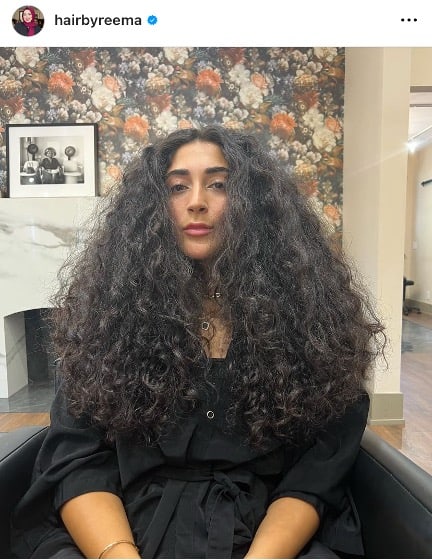For years, haircuts were generalized, regardless of hair type. Over the last decade, various specified curly styles have been curated for curlies. Two popular cuts are trending consistently, and people are asking about the difference between the Cadō and Deva haircuts.

| CADO CUT | DEVA CUT |
| 4-part cutting method | Curl-by-curl cutting method |
| Dry cut | Dry cut |
| Customizable | Customizable |
| Promotes volume | Promotes volume |
| Provides shape | Provides shape |
| Frames face | Frames face |
| For wavy, curly, and coily hair | For wavy, curly, and coily hair |
| Works on any length | Best for shorter lengths |
| May be uneven when straightened | May be uneven when straightened |

From the table above, you can see that both haircuts pretty much hold the same concept. The styles have a lot in common, with a slight difference in cutting methods and a few other factors. We discuss both the Cadōs’ and Devas’ haircuts in detail and their differences in this post.
Understanding the Cadō Haircut
The Cadō haircut is a dry-cutting style specifically for curly hair. It focuses on bringing shape to the hair and framing the face if that’s what a customer wants. Cadō professionals work with the natural pattern of the curls and your hair type to allow your hair to look its best in its natural curly form.


Here are some Cadō haircut facts:
- The Cadō haircut is based on a 4-part-cutting method.
- It can be customized for your hair styling needs. You can choose round, diamond, or flowing layers.
- The cut is not traditional; it focuses on specific curl sections to create flow and balance in the hair.
- It cannot be done on straight hair as it is meant to shape and define your waves or curls.
- It is not recommended for slight waves. Your hair needs to have a wave or curl pattern.
- You may see unevenness if you flat iron your hair after getting a cado cut because it is not a precision cut.
- The haircut can be done on all lengths.
- It complements your hair texture and curl pattern.
- It can be done on fine or thick hair.
- Depending on your hair’s length and thickness, the cut can take around 60-90 minutes.


How to Prep for a Cadō Haircut
- Go in with day one hair, so always wash and detangle (in the shower) before your appointment.
- Style your hair as usual, but try to avoid products or use very little.
- Do not brush your hair, tie it, braid it, or put it up in a bun or any other form.
- Your hair should be completely dry once you get to your appointment.

Founder and Creator of the Cadō Haircut
If you’re wondering who created this curly cut and the fantastic cado cut, that would be Reema Jaber, artist and salon owner of Hair by Reema. Reema is based in Mississauga, Ontario, Canada. She has been working in the hair industry for over 12 years. Check out her work on her Instagram page.
Reema specializes in curly cuts stemming from her interest in curly hair. Another major specialty her brand holds is coloring/blonding. She does not only work with curly hair, but the love and expertise she and her team have put into perfecting natural curls attract more curlies to her salon.
In addition to cutting and coloring hair, Reema Jaber also owns the Cadō Academy, where she teaches and certifies hairstylists who come in to learn the Cadō method. She runs workshops so people across the US and Canada can incorporate and benefit from the Cadō technique.
Understanding the Deva Haircut
The DevaCut is an innovative cutting method designed to give better shape and volume to naturally curly, coily, and wavy hair. Like the Cadō method, it works on dry hair to focus on the natural pattern of your curls. It is a curl-by-curl cutting sculpting process where the hair is cut at an angle.

The technique is done to ensure your natural curl pattern is not disrupted. DevaCut was founded and introduced into the industry more than a decade ago by Devachan Salon and was a revolutionary addition to the curly hair community.
You can find a DevaCurl stylist at several salons across the US. Also, like the Cadō technique, the DevaCut method requires you to have a natural wave or curl definition. This is because it enhances your natural hair type and pattern with wash-and-go styling.
Some facts about the DevaCut:
- It uses a dry-cutting method that cuts your curls “where they live.”
- The DevaCut is also customizable for your hair type, pattern, and texture.
- It is best for hair with a defined pattern. Straight hair and slight waves won’t work for this technique.
- The hair may be uneven once flat ironed. It is best to wear your natural curls with a DevaCut.
- The method can be used on long hair but works best on shorter lengths or curls with more shrinkage.
- Your DevaCut may take between 60 and 90 minutes, depending on your hair’s length and thickness.
- It can be done on fine or thick hair.
You can check out this post for more in-depth information and comparison on the DevaCut.

How to Prepare for a DevaCut
- Wash and detangle (in the shower) before your appointment, and go with day one hair.
- Avoid applying any products and let your hair fall naturally.
- Do not brush, tie, or braid your hair.
- Your hair should be completely dry once you get to your appointment.
DevaCut vs. Cadō Cut: Which one should you choose?
As you’ve probably deduced from the above information, both cutting techniques are intensely similar. Both offer shaping, face-framing, volume, and curl pattern enhancement. Your primary deciding factor would depend only on a few things:
- Which option is more conveniently available based on location and stylist availability.
- The price point of your specific salon and stylist.
- If you want to get coloring/blonding done from Cadō technique expertise or not.
- If you plan to only style by wash-and-go or would like to occasionally enjoy a blowout. The latter would favor a Cadō Cut.
The Cons of Cado and Deva Haircuts
- While these haircuts are ideal for natural curlies and seem the answer to all your curly hair problems, they have some negatives. Let’s look at what those are:
- These cuts are unlikely to address much of your split or dead ends unless you cut a significant amount of inches off your length. Remember that not all your hair gets a full chop. Just the sections of curls that require shaping.
- It can be frustrating for those curlies who want a curly cut but also enjoy blowouts and flat ironing on occasion. Your hair may have a lot of unevenness, reducing your styling options to wash-and-goes or up styles.
- Curly cuts can be much more expensive and take longer than regular cuts. You must always plan and accommodate for these factors.
- If your hair does not always fall on the same after every wash (curly hair rarely does), you may notice random sections that are out of shape and don’t look styled as they did after your initial cut. You either must keep cutting those curls or have random pieces that don’t fit in.
Conclusion
Cadō and DevaCuts are excellent ways to get the best results from your curls in their natural form. Always go with what works best for you and a hairstylist you feel most comfortable with. You’re sure to get stunning results regardless of which option you choose.















